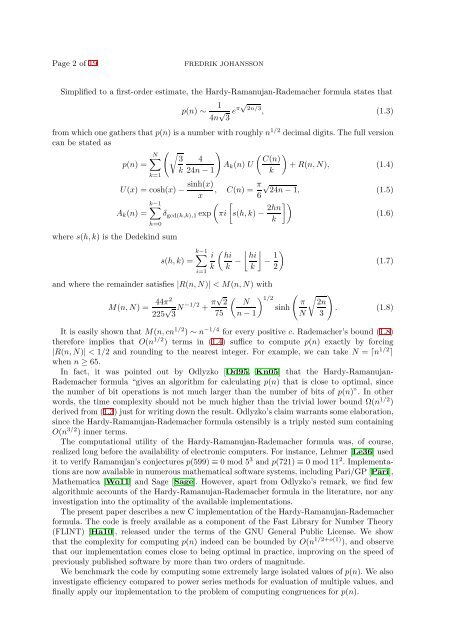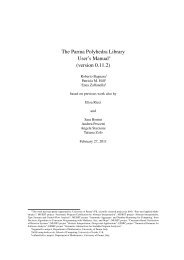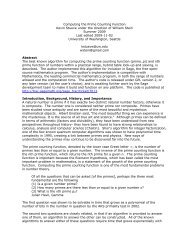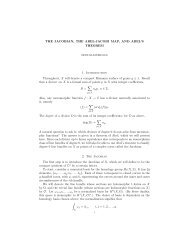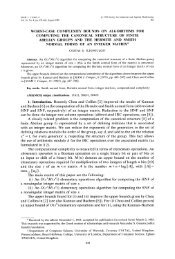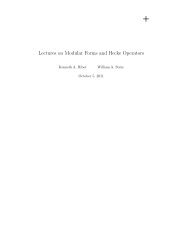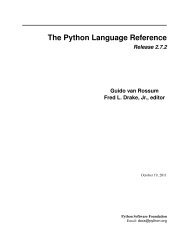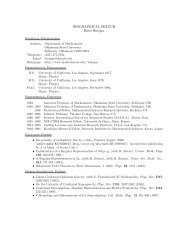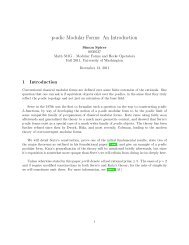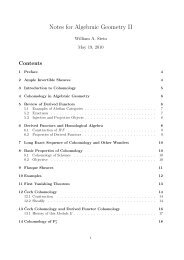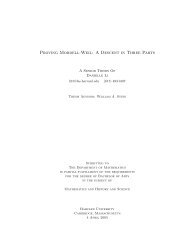Efficient implementation of the Hardy-Ramanujan ... - William Stein
Efficient implementation of the Hardy-Ramanujan ... - William Stein
Efficient implementation of the Hardy-Ramanujan ... - William Stein
Create successful ePaper yourself
Turn your PDF publications into a flip-book with our unique Google optimized e-Paper software.
Page 2 <strong>of</strong> 19<br />
FREDRIK JOHANSSON<br />
Simplified to a first-order estimate, <strong>the</strong> <strong>Hardy</strong>-<strong>Ramanujan</strong>-Rademacher formula states that<br />
p(n) ∼ 1<br />
4n √ 3 eπ√ 2n/3 , (1.3)<br />
from which one ga<strong>the</strong>rs that p(n) is a number with roughly n 1/2 decimal digits. The full version<br />
can be stated as<br />
(√ )<br />
N∑<br />
( )<br />
3 4 C(n)<br />
p(n) = A k (n) U +R(n,N), (1.4)<br />
k 24n−1 k<br />
k=1<br />
U(x) = cosh(x)− sinh(x) , C(n) = π 24n−1, (1.5)<br />
x 6√<br />
k−1<br />
∑<br />
( [<br />
A k (n) = δ gcd(h,k),1 exp πi s(h,k)− 2hn ])<br />
(1.6)<br />
k<br />
h=0<br />
where s(h,k) is <strong>the</strong> Dedekind sum<br />
s(h,k) =<br />
k−1<br />
∑<br />
i=1<br />
( ⌊ ⌋<br />
i hi hi<br />
k k − − 1 )<br />
k 2<br />
and where <strong>the</strong> remainder satisfies |R(n,N)| < M(n,N) with<br />
M(n,N) = 44π2<br />
225 √ 3 N−1/2 + π√ ( ) 1/2<br />
2 N π 2n<br />
sinh(<br />
75 n−1 N√<br />
3<br />
)<br />
(1.7)<br />
. (1.8)<br />
It is easily shown that M(n,cn 1/2 ) ∼ n −1/4 for every positive c. Rademacher’s bound (1.8)<br />
<strong>the</strong>refore implies that O(n 1/2 ) terms in (1.4) suffice to compute p(n) exactly by forcing<br />
|R(n,N)| < 1/2 and rounding to <strong>the</strong> nearest integer. For example, we can take N = ⌈n 1/2 ⌉<br />
when n ≥ 65.<br />
In fact, it was pointed out by Odlyzko [Od95, Kn05] that <strong>the</strong> <strong>Hardy</strong>-<strong>Ramanujan</strong>-<br />
Rademacher formula “gives an algorithm for calculating p(n) that is close to optimal, since<br />
<strong>the</strong> number <strong>of</strong> bit operations is not much larger than <strong>the</strong> number <strong>of</strong> bits <strong>of</strong> p(n)”. In o<strong>the</strong>r<br />
words, <strong>the</strong> time complexity should not be much higher than <strong>the</strong> trivial lower bound Ω(n 1/2 )<br />
derived from (1.3) just for writing down <strong>the</strong> result. Odlyzko’s claim warrants some elaboration,<br />
since <strong>the</strong> <strong>Hardy</strong>-<strong>Ramanujan</strong>-Rademacher formula ostensibly is a triply nested sum containing<br />
O(n 3/2 ) inner terms.<br />
The computational utility <strong>of</strong> <strong>the</strong> <strong>Hardy</strong>-<strong>Ramanujan</strong>-Rademacher formula was, <strong>of</strong> course,<br />
realized long before <strong>the</strong> availability <strong>of</strong> electronic computers. For instance, Lehmer [Le36] used<br />
it to verify <strong>Ramanujan</strong>’s conjectures p(599) ≡ 0 mod 5 3 and p(721) ≡ 0 mod 11 2 . Implementations<br />
are now available in numerous ma<strong>the</strong>matical s<strong>of</strong>tware systems, including Pari/GP[Pari],<br />
Ma<strong>the</strong>matica [Wo11] and Sage [Sage]. However, apart from Odlyzko’s remark, we find few<br />
algorithmic accounts <strong>of</strong> <strong>the</strong> <strong>Hardy</strong>-<strong>Ramanujan</strong>-Rademacher formula in <strong>the</strong> literature, nor any<br />
investigation into <strong>the</strong> optimality <strong>of</strong> <strong>the</strong> available <strong>implementation</strong>s.<br />
The present paper describes a new C <strong>implementation</strong> <strong>of</strong> <strong>the</strong> <strong>Hardy</strong>-<strong>Ramanujan</strong>-Rademacher<br />
formula. The code is freely available as a component <strong>of</strong> <strong>the</strong> Fast Library for Number Theory<br />
(FLINT) [Ha10], released under <strong>the</strong> terms <strong>of</strong> <strong>the</strong> GNU General Public License. We show<br />
that <strong>the</strong> complexity for computing p(n) indeed can be bounded by O(n 1/2+o(1) ), and observe<br />
that our <strong>implementation</strong> comes close to being optimal in practice, improving on <strong>the</strong> speed <strong>of</strong><br />
previously published s<strong>of</strong>tware by more than two orders <strong>of</strong> magnitude.<br />
We benchmark <strong>the</strong> code by computing some extremely large isolated values <strong>of</strong> p(n). We also<br />
investigate efficiency compared to power series methods for evaluation <strong>of</strong> multiple values, and<br />
finally apply our <strong>implementation</strong> to <strong>the</strong> problem <strong>of</strong> computing congruences for p(n).


